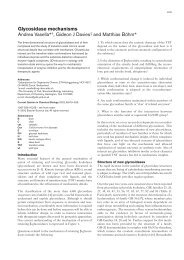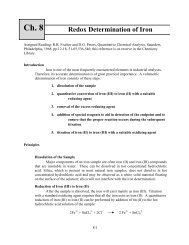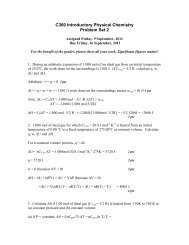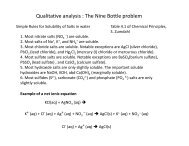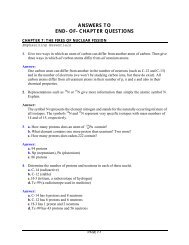ANSWERS TO END-OF-CHAPTER QUESTIONS
ANSWERS TO END-OF-CHAPTER QUESTIONS
ANSWERS TO END-OF-CHAPTER QUESTIONS
You also want an ePaper? Increase the reach of your titles
YUMPU automatically turns print PDFs into web optimized ePapers that Google loves.
large hybrid vehicles such as SUVs.) Hybrid vehicles generally have fewer emissions (CO,<br />
CO2, NOx, and particulate matter) than gasoline-powered cars. When hybrid vehicles are<br />
running on the electricity generated by braking, they are not depleting fossil fuel supplies.<br />
However, the greater consumer familiarity and lower price of gasoline-powered vehicles<br />
makes them attractive to many people.<br />
40. William C. Ford, Jr., chairman of the board of Ford Motor Company, is quoted as saying that<br />
going “totally green” with zero-emissions vehicles will be a real challenge. Regular drivers<br />
won’t buy high-tech clean cars, Ford admits, until the industry has a “no-trade-off” vehicle<br />
widely available. What do you think he means by a no-trade-off vehicle? Do you think he is<br />
justified in this opinion?<br />
Answer:<br />
A no-trade-off vehicle will perform just as well as a gasoline vehicle at the same price (and<br />
still have zero emissions). Although Mr. Ford’s words may have made sense when he spoke<br />
them, they are less true today (2007 as the 6 th edition goes to press). Those working in the<br />
industry are seeing the need to “go green” and are finding that “green” practices give them a<br />
competitive edge and that people are buying them.<br />
41. Fuel cells were invented in 1839, but never developed into practical devices for producing<br />
electrical energy until the U.S. space program in the 1960s. What advantages did fuel cells<br />
have over previous power sources?<br />
Answer:<br />
The space program required reliable, relatively lightweight power sources. Fuels cells, when<br />
compared to other types of batteries that were available at that time, met those specifications<br />
and did not “run down” or require recharging. A fuel cell will continue to operate as long as<br />
fuel is available.<br />
42. Hydrogen, H2, and methane, CH4, can each be used with oxygen in a fuel cell. Hydrogen and<br />
methane also can be burned directly. Which has greater heat content when burned, 1.00 g of<br />
H2 or 1.00 g of CH4? Hint: Write the balanced chemical equation for each reaction and use<br />
the bond energies in Table 4.2 to help answer this question.<br />
Answer:<br />
The bond energies listed in Table 4.2 for bonds breaking and forming in gases can be used to<br />
calculate the following heats of combustion. These differ somewhat from the values given in<br />
the beginning of this chapter, where the product water is given in the liquid state.<br />
H2(g) + ½ O2(g) ⎯→ H2O(g) heat of combustion = 249 kJ/mol<br />
CH4(g) + 2 O2(g) ⎯→ CO2(g)+ 2 H2O(g) heat of combustion = 814 kJ/mol<br />
In each case, the units of the calculated heat of combustion can be changed to kJ/gram by<br />
dividing by the molar mass of the fuel.<br />
249 kJ<br />
For hydrogen: " 1 mol H2 = 124 kJ<br />
For methane:<br />
!<br />
!<br />
mol H2 2.01g H2 814 kJ<br />
mol CH4 " 1 mol CH4 16.0 g CH4 g H 2<br />
= 50.9 kJ<br />
PAGE 8-14<br />
g CH 4



